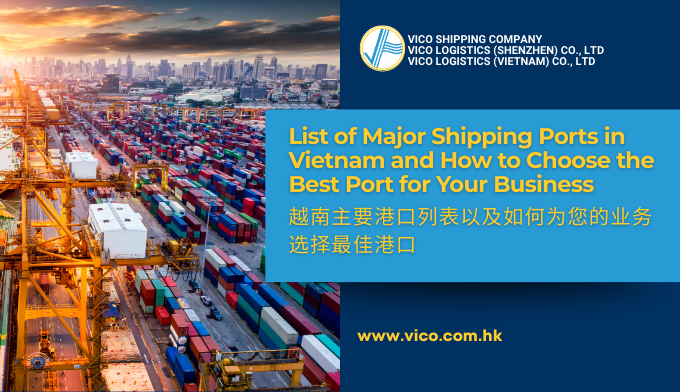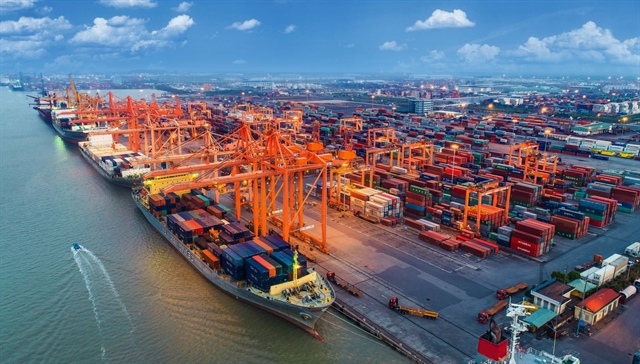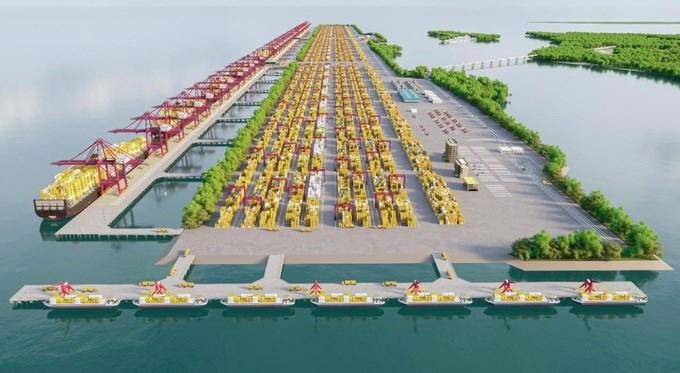
| Table of Contents Introduction: Why Port Choice Matters in Vietnam Vietnam’s Seaport Landscape: 2025 Snapshot Vietnam Regional Shipping Port Clusters and Their Roles Key Functions of Vietnam’s Major Ports Recent Developments and Policy Updates How Port Choice Impacts Freight Cost and Transit Time How VICO Logistics Helps Shippers with Port Selection & Supply Chain Solutions |
Introduction
Vietnam has rapidly transformed into one of Asia’s most competitive manufacturing and shipping hubs. With a coastline stretching over 3,200 kilometers and strategically located along major global trade lanes, the country has invested heavily in modernizing its seaport infrastructure. Today, choosing the right port in Vietnam isn’t just a matter of convenience—it’s a strategic business decision that directly impacts shipping costs, delivery speed, and overall supply chain performance.

Source:enternews.vn
For manufacturers, exporters, and importers, the choice of port can determine whether goods arrive on time, at the right cost, and with minimal risk. A company shipping electronics from northern Vietnam might save thousands of dollars by using Hai Phong’s deep-water terminals instead of routing through southern ports. Similarly, an exporter in Ho Chi Minh City could cut days off transit time and avoid congestion by shifting cargo to Cai Mep–Thi Vai.
In this article, we’ll break down Vietnam’s port landscape, examine the strengths of its major seaports, and show you exactly how to select the best port for faster, more cost-effective shipping in 2025.
1.Vietnam’s Seaport Landscape: 2025 Snapshot
Vietnam’s port system is massive and growing rapidly. According to the Ministry of Transport’s official planning documents, the country operates between 286 to 296 terminals and ports, depending on classification. These facilities include general cargo wharves, specialized berths for industries like oil and coal, and world-class container terminals.
In 2024, Vietnam handled nearly 700 million tonnes of cargo, including close to 30 million TEUs of containerized goods. This puts the country in the same league as established global players like Thailand and Malaysia. Three of its ports — Saigon Port (Ho Chi Minh City), Hai Phong, and Cai Mep–Thi Vai — are consistently ranked among the world’s Top 50 container ports, proving Vietnam’s role as a rising star in international shipping.
But statistics alone don’t tell the full story. Vietnam’s seaports are part of an interconnected logistics ecosystem that links factories in Hanoi, Da Nang, and Ho Chi Minh City with global markets in the U.S., Europe, and Asia. The government’s Seaport Master Plan to 2030 aims to raise capacity to 1.5 billion tonnes annually, supported by investments of nearly USD 13 billion in dredging, green port initiatives, and smarter hinterland connections.
>> How to Optimize Textile Logistics with VICO's China-Vietnam LCL Consolidation Service
2. Vietnam Regional Shipping Port Clusters and Their Roles
2.1 Northern Region
Hai Phong / Lach Huyen Port
Hai Phong is the largest port in northern Vietnam and the primary gateway for exports from Hanoi and nearby industrial zones. Its facilities include the Lach Huyen deep-water terminal, which allows Ultra-Large Container Ships (ULCS) to dock directly. This reduces reliance on transshipment through Singapore or Hong Kong, saving both time and cost.
Electronics, textiles, and heavy machinery dominate Hai Phong’s cargo mix. Thanks to its direct connections to Europe and Asia, it is increasingly the port of choice for companies in Bac Ninh and Hai Duong, where Samsung, Canon, and other global manufacturers have major plants.
Quang Ninh (Cai Lan Port)
Located near the Chinese border, Cai Lan Port is a deep-water facility specializing in coal, bulk cargo, and cross-border trade with southern China. While it doesn’t match Hai Phong in container volume, its strategic location makes it vital for industries tied to raw materials and regional trade.
2.2 Central Region
Da Nang Port
Da Nang is the main international port in central Vietnam and a key hub along the East-West Economic Corridor (EWEC), which links Laos, Thailand, and Myanmar to the South China Sea. This makes it an attractive choice for companies moving goods across Indochina.
As a transshipment hub, Da Nang handles both imports for the central provinces and exports of agricultural and seafood products. With modernization projects underway, it’s increasingly able to handle larger vessels and expand its role in regional trade.
Quy Nhon & Vung Ang Ports
These smaller ports serve specialized roles:
Quy Nhon Port connects the Central Highlands’ coffee and agricultural exports to global markets. Vung Ang Port supports mining and industrial goods, with growing links to Laos.
Da Nang Port acts as Central Vietnam’s main international shipping hub and plays a vital role on the East-West Economic Corridor, linking Laos, Thailand, and Myanmar to the South China Sea. It also functions as a transshipment point for nearby provinces.Quy Nhon and Vung Ang Ports support inland Central Highlands industries and mining areas, moving agricultural products, industrial inputs, and bulk commodities. Quy Nhon, in particular, is expanding its international routes.
2.3 Southern Region
The south is Vietnam’s industrial powerhouse, home to Ho Chi Minh City and neighboring provinces where most of the country’s exports are produced.
Saigon Port Cluster (Cat Lai & Tan Cang Terminals)

This is the busiest container hub in Vietnam, handling the majority of exports and imports. Cat Lai Terminal, in particular, is known for its massive throughput. However, congestion and land constraints often cause delays and higher inland trucking costs.
Cai Mep–Thi Vai Deep-Water Port
Located in Ba Ria–Vung Tau, Cai Mep is a deep-water port designed for direct global shipping. It can handle vessels of up to 200,000 DWT, making it one of the few Southeast Asian ports capable of receiving ultra-large container ships. For exporters in southern Vietnam, this means skipping transshipment in Singapore, cutting both time and cost.
Vung Tau Port Cluster
Traditionally focused on oil and gas logistics, Vung Tau is expanding into container shipping. Its proximity to offshore industries makes it strategically important.
3. Key Functions of Vietnam’s Major Ports
Port/Cluster | Key Functions & Strategic Role |
Hai Phong / Lach Huyen | Northern Vietnam’s primary international container gateway. A modern deep-water terminal (Lach Huyen) handles ULCS, supports cross-border connectivity, and boosts regional trade efficiency. |
Quang Ninh (Cai Lan) | Deep-water port oriented toward bulk commodities (like coal) and cross-border trade with South China. Key for northern industrial and resource sectors. |
Da Nang | Central Vietnam’s main seaport and pivotal node on the East-West Economic Corridor, facilitating imports, exports, and transshipment to and from ASEAN countries. |
Quy Nhon & Vung Ang | Regional ports serving central inland regions. Quy Nhon handles agricultural exports (e.g. coffee), while Vung Ang supports industrial and mining logistics. |
Saigon Port (Cat Lai/Tan Cang) | Southern Vietnam’s largest container complex. It's the busiest port for imports and exports, especially for electronics, textiles, and footwear. |
Cai Mep–Thi Vai | Deep-water international hub for direct global container shipping, bypassing transshipment hubs. Capable of handling very large vessels and supports growing US and European trade. |
Vung Tau | Strategic oil-and-gas logistics hub and emerging container port. Located in a resource-rich region, with increasing capacity for heavy and energy-related cargo. |
4. Recent Developments and Policy Context of Vietnam Shipping ports
Vietnam is not resting on its current success. The government’s Seaport Master Plan 2030 lays out ambitious goals:
Capacity Expansion: Raising handling capacity to 1.25–1.5 billion tonnes annually.
Investment: Allocating USD 12.8–13.7 billion for modernization.
Green Ports: Promoting sustainability through eco-friendly dredging and electrification.
Smart Ports: Introducing digital tracking, automated terminals, and AI-driven logistics.
Recent highlights include:
New smart container terminals in Hai Phong with automated cranes.
Expanded facilities at Cai Mep–Thi Vai, making it more attractive to major shipping alliances.
Upgraded berths in Ba Ria–Vung Tau, capable of handling larger vessels.
These improvements reduce Vietnam’s reliance on foreign transshipment hubs and position it as a direct competitor to Singapore, Hong Kong, and Port Klang (Malaysia).
5. How Port Choice Impacts Cost and Transit Time
Port selection isn’t just about geography—it has a direct impact on shipping costs, delivery speed, and even supply chain reliability. Let’s break it down with practical examples.
Port selection isn’t just about geography—it has a direct impact on shipping costs, delivery speed, and even supply chain reliability. Let’s break it down with practical examples.
5.2 Northern vs. Southern Manufacturers
A manufacturer in Hanoi has two main choices:
Ship through Hai Phong/Lach Huyen, which provides direct routes to Asia and Europe.
Or move cargo south to Saigon/Cai Mep, which can sometimes mean better global connections but adds inland trucking costs of $1,000+ per container and 2–3 extra days of transit.
The lesson? Proximity matters. For northern factories, Hai Phong saves time and reduces unnecessary inland transport. For southern exporters, Cai Mep avoids costly transshipment via Singapore.
5.3 Congestion Costs at Saigon Port
Saigon’s Cat Lai is Vietnam’s busiest container terminal. While it handles huge volumes, it often suffers from congestion. Truck queues, customs bottlenecks, and limited yard space can delay shipments by 24–48 hours. This not only increases storage costs but can also cause missed sailings—something global exporters can’t afford.
Shifting to Cai Mep may involve slightly longer trucking distances from Ho Chi Minh City, but the direct vessel calls to Europe and the U.S. often result in lower overall freight costs and faster delivery times.
5.4 LCL vs. FCL Considerations
Less-than-Container Load (LCL): Smaller shipments benefit from direct-call ports like Cai Mep or Hai Phong because they minimize the number of handlings, reducing the risk of damage and lowering transshipment fees.
Full Container Load (FCL): High-volume exporters can save big by consolidating shipments through direct global ports, even if inland trucking is slightly more expensive.
5.5. Transshipment vs. Direct Calls

Vietnam historically relied on Singapore and Hong Kong for transshipment. But direct calls from Cai Mep to Los Angeles, Rotterdam, and Hamburg now bypass those hubs. The result? Transit times are reduced by 5–7 days, and costs per container can drop by $300–500.
👉 The bottom line: Choosing the wrong port can quietly drain profits, while the right port can be a game-changer for competitiveness.
6. How VICO Logistics Supports Shippers with Vietnam Shipping Port Selection and Supply Chain Solutions
1. Cost Modeling & Route Planning: By comparing total costs (inland trucking, port tariffs, ocean freight), logistics providers identify the true cheapest route—not just the closest one.
2. Carrier Negotiations: With strong relationships with shipping lines, they can secure space guarantees and better rates at strategic ports.
3. Customs Expertise: Understanding which ports have faster clearance and which cargo types face scrutiny helps minimize delays.
4. End-to-End Integration: Logistics partners align port choice with factory schedules, warehousing, and customer delivery windows.
Conclusion
Vietnam’s port network is expanding rapidly, with strategic investments that enhance capacity and connectivity. By selecting the most suitable port — whether it’s the deep-water Cai Mep–Thi Vai, the industrial hub of Hai Phong, or the central gateway of Da Nang — shippers can optimize their Vietnam freight cost and improve supply chain efficiency. Partnering with an experienced logistics provider ensures that port selection aligns with both commercial needs and operational realities.
Learn more our article
Guide to Exporting and Transporting PVC Resin from Vietnam to Cambodia - VICO Logistics
Understand the Quotation of Cross-Border Trucking from Vietnam to Cambodia | VICO Logistics
Common Types of Warehouses in Vietnam and How to Choose the Right One
---
VICO Logistics – Your Indochina Expert
Premium member of Eurocham, JCtrans, VICOFA, VITAS... associations
Owned offices: Hong Kong (headquarters), China (Shenzhen, Shanghai), Vietnam (Ho Chi Minh, Da Nang, Hai Phong).
Youtube - Linkedin - Fanpage
Follow us for more valuable information
Book now: https://vico.com.hk/#quotation
Contact us:
- Email mkt4_hcm@vico.com.hk (For business development)
- Hotline: Zalo/Whatsapp: (+84)901877108
- WeChat China: Schyler_skylar (CN/EN)
- WeChat Vietnam: miauyen1577 (VN/EN)






